height TOYOTA PRIUS PLUG-IN HYBRID 2021 Owners Manual
[x] Cancel search | Manufacturer: TOYOTA, Model Year: 2021, Model line: PRIUS PLUG-IN HYBRID, Model: TOYOTA PRIUS PLUG-IN HYBRID 2021Pages: 816, PDF Size: 132.85 MB
Page 35 of 816
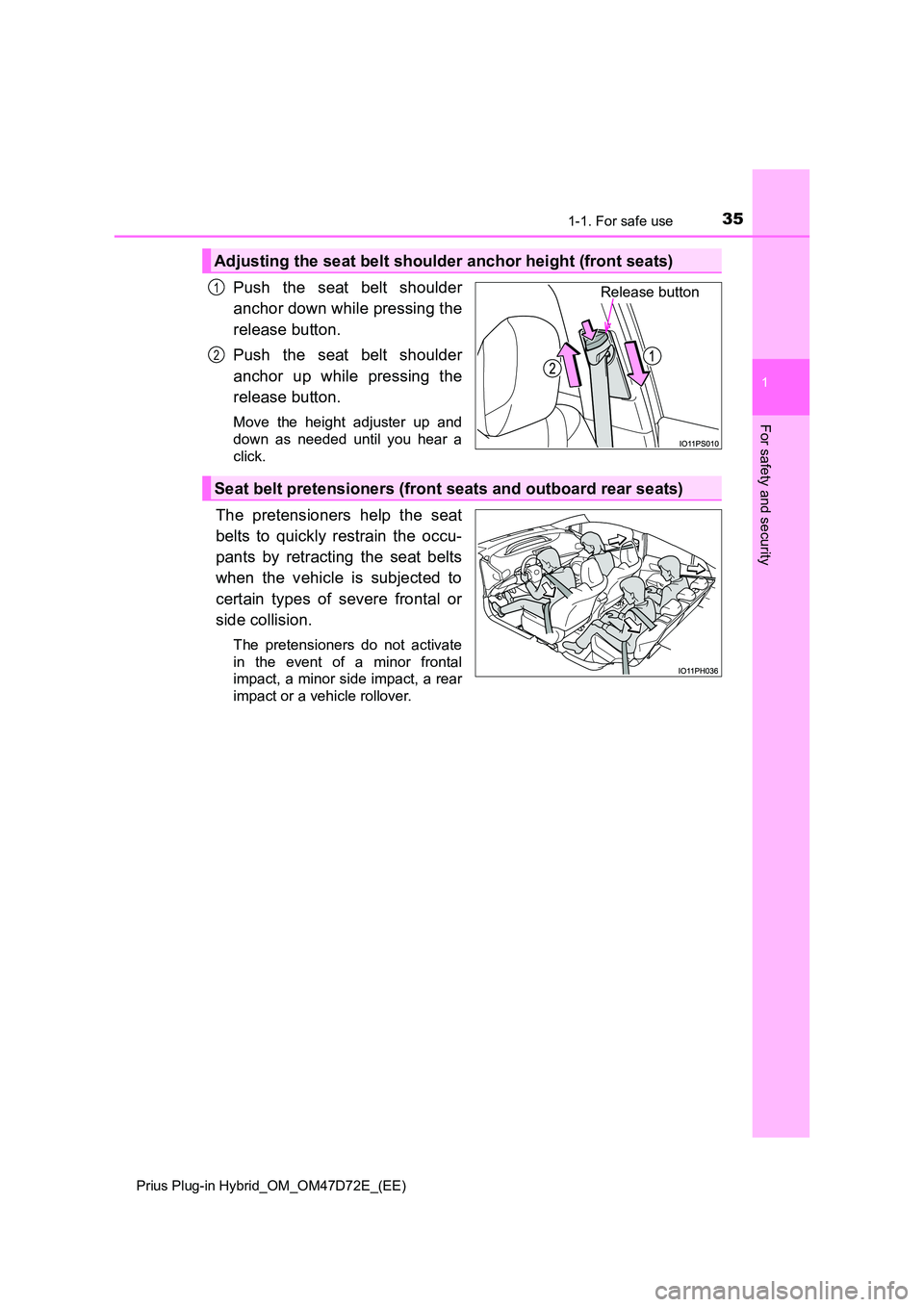
351-1. For safe use
1
Prius Plug-in Hybrid_OM_OM47D72E_(EE)
For safety and security
Push the seat belt shoulder
anchor down while pressing the
release button.
Push the seat belt shoulder
anchor up while pressing the
release button.
Move the height adjuster up and
down as needed until you hear a
click.
The pretensioners help the seat
belts to quickly restrain the occu-
pants by retracting the seat belts
when the vehicle is subjected to
certain types of severe frontal or
side collision.
The pretensioners do not activate
in the event of a minor frontal
impact, a minor side impact, a rear
impact or a vehicle rollover.
Adjusting the seat belt shoulder anchor height (front seats)
Release button1
2
Seat belt pretensioners (front seats and outboard rear seats)
Page 59 of 816
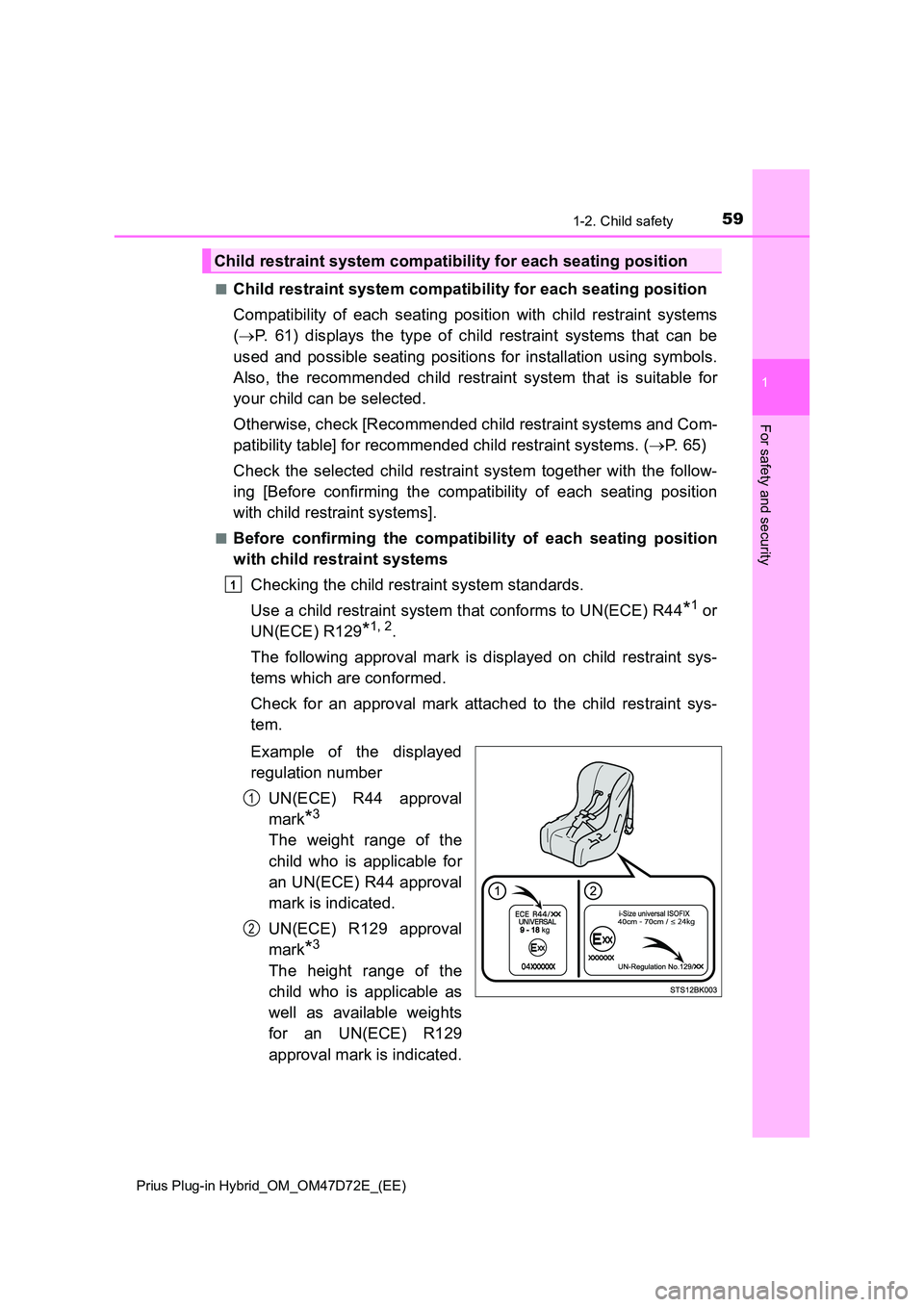
591-2. Child safety
1
Prius Plug-in Hybrid_OM_OM47D72E_(EE)
For safety and security
■Child restraint system compatibility for each seating position
Compatibility of each seating position with child restraint systems
( P. 61) displays the type of child restraint systems that can be
used and possible seating positions for installation using symbols.
Also, the recommended child restraint system that is suitable for
your child can be selected.
Otherwise, check [Recommended child restraint systems and Com-
patibility table] for recommended child restraint systems. ( P. 6 5 )
Check the selected child restraint system together with the follow-
ing [Before confirming the compatibility of each seating position
with child restraint systems].
■Before confirming the compatibility of each seating position
with child restraint systems
Checking the child restraint system standards.
Use a child restraint system that conforms to UN(ECE) R44*1 or
UN(ECE) R129*1, 2.
The following approval mark is displayed on child restraint sys-
tems which are conformed.
Check for an approval mark attached to the child restraint sys-
tem.
Example of the displayed
regulation number
UN(ECE) R44 approval
mark*3
The weight range of the
child who is applicable for
an UN(ECE) R44 approval
mark is indicated.
UN(ECE) R129 approval
mark*3
The height range of the
child who is applicable as
well as available weights
for an UN(ECE) R129
approval mark is indicated.
Child restraint system compatibility for each seating position
1
1
2
Page 62 of 816

621-2. Child safety
Prius Plug-in Hybrid_OM_OM47D72E_(EE)
*1: Move the front seat fully rearward. If the passenger seat height can be
adjusted, move it to the upper most position.
*2: Adjust the seatback angle to the
most upright position.
When installing a forward-facing
child seat, if there is a gap between
the child seat and the seatback,
adjust the seatback angle until
good contact is achieved.
*3: If the head restraint interferes with your child restraint system, and the
head restraint can be removed, remove the head restraint.
Otherwise, put the head restraint in the upper most position.
*4: Use only a front-facing child restraint system when the airbag manual on-
off switch is on.
Page 64 of 816

641-2. Child safety
Prius Plug-in Hybrid_OM_OM47D72E_(EE)
ISOFIX child restraint systems are divided into different “fixture”.
The child restraint system can be used in the seating positions for
“fixture” mentioned in the table above. For kind of “fixture” relation,
confirm the following table.
If your child restraint system has no kind of “fixture” (or if you can-
not find information in the table below), please refer to the child
restraint system “vehicle list” for compatibility information or ask the
retailer of your child seat.
FixtureDescription
F3 Full-height, forward-facing child restraint systems
F2 Reduced-height forward-facing child restraint systems
F2X Reduced-height forward-facing child restraint systems
R3 Full-size, rearward-facing child restraint systems
R2 Reduced-size, rearward-facing child restraint systems
R2X Reduced-size, rearward-facing child restraint systems
R1 Rearward-facing infant seat
L1 Left lateral-facing (carrycot) infant seat
L2 Right lateral-facing (carrycot) infant seat
B2 Junior seat
B3 Junior seat
Page 165 of 816

165
2
2-2. Charging
Plug-in hybrid system
Prius Plug-in Hybrid_OM_OM47D72E_(EE)
How to charge
P. 1 6 1
Prepare the charging cable.
When using the Mode 2 charging cable
Make sure to hold the body of
the plug and insert it firmly into
the socket.
If you have a remote switch, turn it
on.
Check that the power indicator on
the CCID (Charging Circuit Inter-
rupting Device) is illuminated. (If it
is not illuminated, refer to P. 192)
Use a string, etc. to hang the CCID
(Charging Circuit Interrupting
Device) on a hook or equivalent
when a load is applied to the
socket and plug due to the installa-
tion height of the socket.
The CCID (Charging Circuit Inter-
rupting Device) can be hung by
using the hole in the back.
Do not attach the CCID (Charging
Circuit Interrupting Device) to the
wall with screws.
This section explains the procedure for charging the hybrid bat-
tery (traction battery) with the equipped charging cable.
When using a charging station, make sure to check the opera-
tion instructions on the charging station.
When the charge schedule is registered, make sure “Charge Now”
is turned on before charging. ( P. 184)
Confirm the following before charging
When charging
1
2
Page 258 of 816

2583. Instrument cluster
Prius Plug-in Hybrid_OM_OM47D72E_(EE)
■Settings table
ItemSettingsSetting result
“On”
Turns the LTA (Lane Tracing Assist) lane
centering function on and off. (P. 429)
“Off”
“On”
Turns the LTA (Lane Tracing Assist) steer-
ing assist function on and off. (P. 429)
“Off”
“High”Switches the LTA (Lane Tracing Assist)
alert sensitivity. (P. 429)
“Standard”
“On”
Turns the PCS (Pre-Collision System) on
and off. (P. 422)
“Off”
Early
Switches the PCS (Pre-Collision System)
warning timing. (P. 422)Middle
Late
*1“On”Turns the Toyota parking assist-sensor on
and off. (P. 499)
“Off”
*1“On”Turns the Parking Support Brake function
on and off. (P. 512)
“Off”
*1“On”Turns the Blind Spot Monitor on and off.
(P. 474)
“Off”
“On”
Turns the LTA (Lane Tracing Assist) vehicle
sway warning on and off. (P. 429)
“Off”
“High”
Switches the LTA (Lane Tracing Assist)
vehicle sway warning sensitivity. (P. 4 2 9 )“Standard”
“Low”
*1HeightChanges the display position and bright-
ness of the head-up display. (P. 267)
Brightness
“On”
Turns the RSA (Road Sign Assist) on and
off. (P. 445)
“Off”
“On”Turns the Dynamic Radar Cruise Control
with Road Sign Assist on and off.
(P. 463)
“Off”
Page 339 of 816
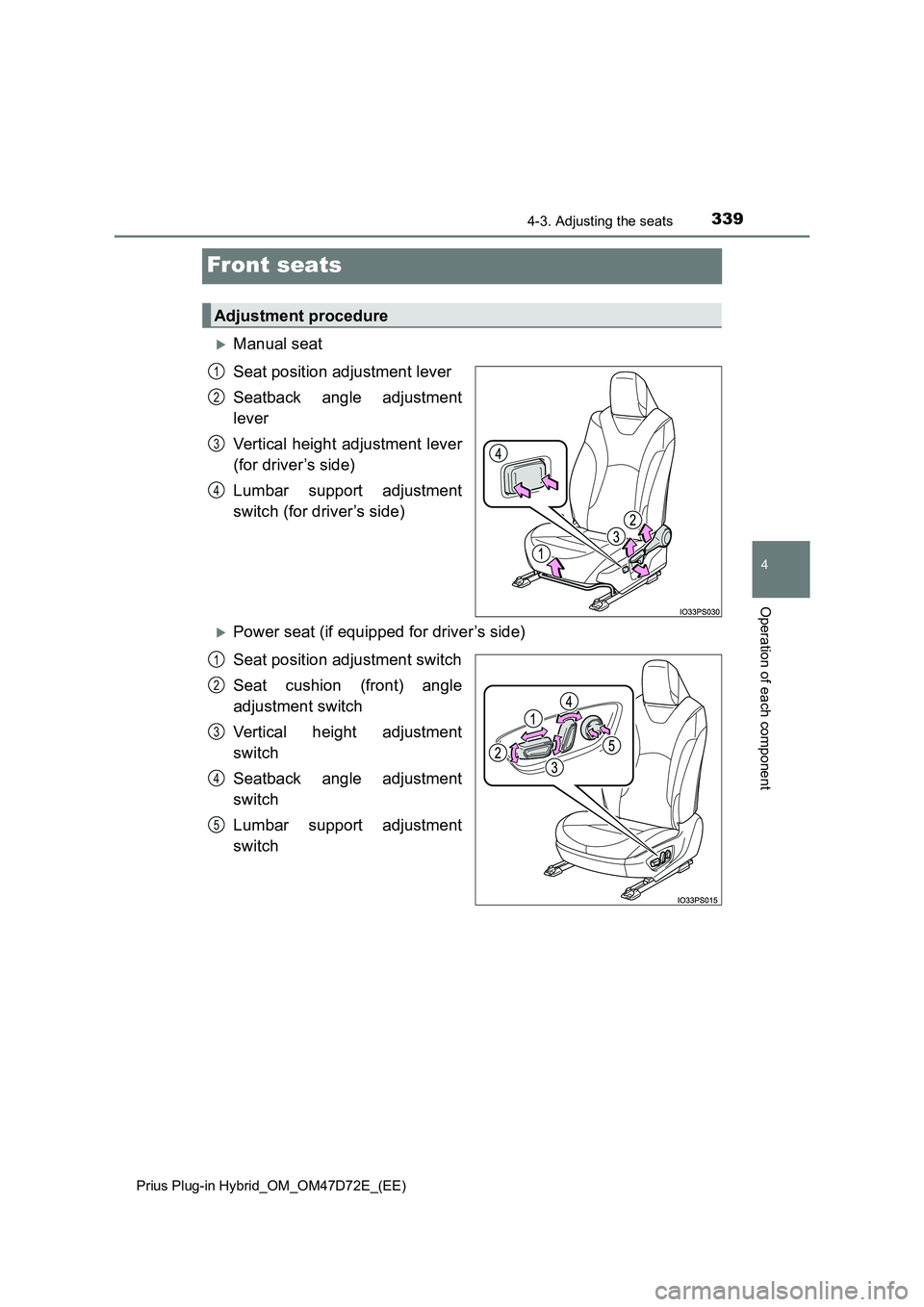
3394-3. Adjusting the seats
Prius Plug-in Hybrid_OM_OM47D72E_(EE)
4
Operation of each component
Front seats
Manual seat
Seat position adjustment lever
Seatback angle adjustment
lever
Vertical height adjustment lever
(for driver’s side)
Lumbar support adjustment
switch (for driver’s side)
Power seat (if equipped for driver’s side)
Seat position adjustment switch
Seat cushion (front) angle
adjustment switch
Vertical height adjustment
switch
Seatback angle adjustment
switch
Lumbar support adjustment
switch
Adjustment procedure
1
2
3
4
1
2
3
4
5
Page 345 of 816

3454-3. Adjusting the seats
Prius Plug-in Hybrid_OM_OM47D72E_(EE)
4
Operation of each component
Rear outboard seats
■ Adjusting the height of the head restraints (front seats)
■ Adjusting the rear seat head restraint
Always raise the head restraint one level from the stowed position when
using.
Pull the seatback lock release lever and
fold down the seatback until it reaches
the position where the head restraints
can be installed.
Align the head restraint with the installa-
tion holes and push it down to the lock
position.
Press and hold the lock release button
when lowering the head restraint.
Make sure that the head restraints are
adjusted so that the center of the head
restraint is closest to the top of your ears.
WARNING
■ Head restraint precautions
Observe the following precautions regarding the head restraints. Failure to
do so may result in death or serious injury.
● Use the head restraints designed for each respective seat.
● Adjust the head restraints to the correct position at all times.
● After adjusting the head restraints, push down on them and make sure
they are locked in position.
● Do not drive with the head restraints removed.
1
2
Lock release
button
Page 348 of 816
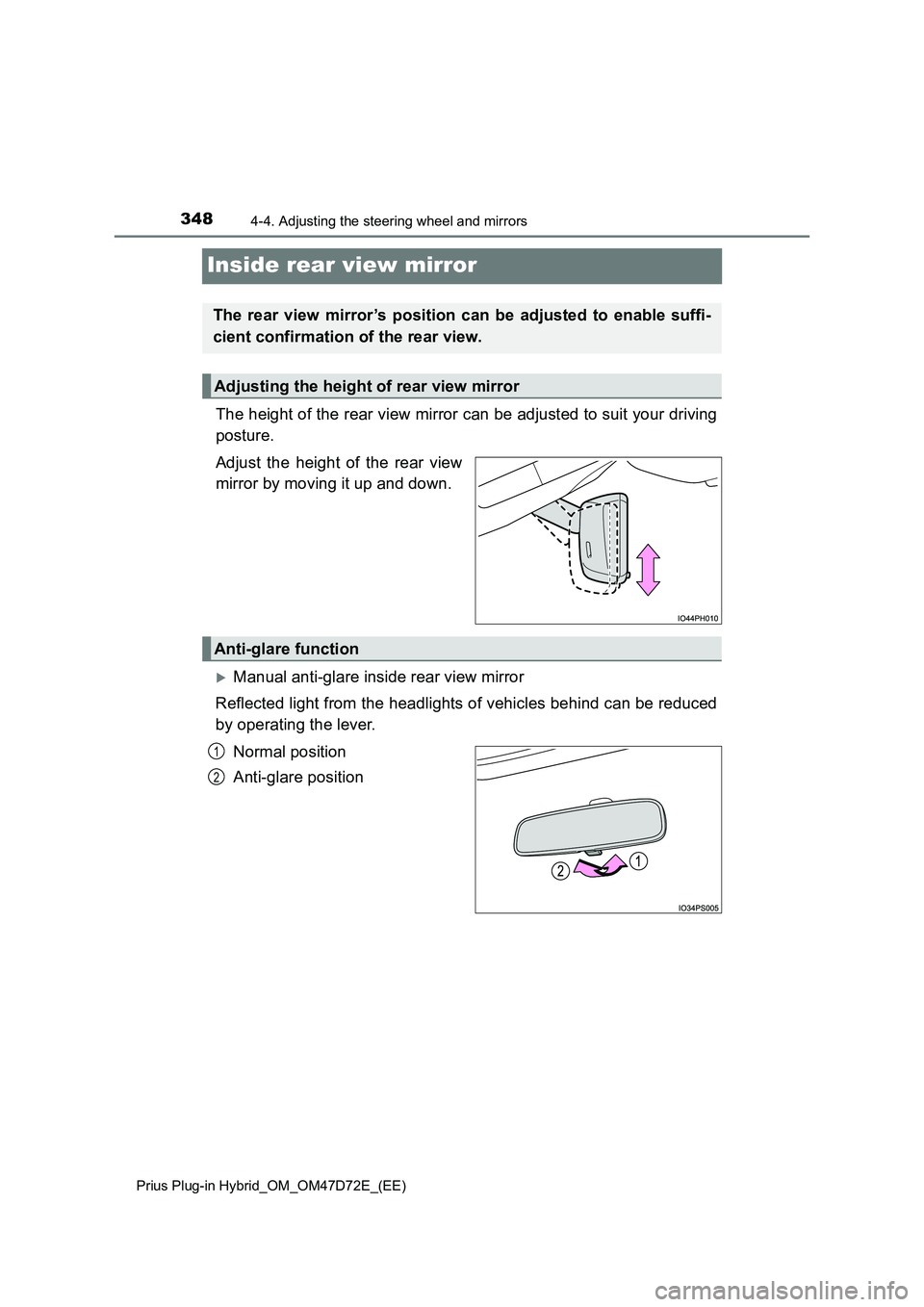
3484-4. Adjusting the steering wheel and mirrors
Prius Plug-in Hybrid_OM_OM47D72E_(EE)
Inside rear view mirror
The height of the rear view mirror can be adjusted to suit your driving
posture.
Adjust the height of the rear view
mirror by moving it up and down.
Manual anti-glare inside rear view mirror
Reflected light from the headlights of vehicles behind can be reduced
by operating the lever.
Normal position
Anti-glare position
The rear view mirror’s position can be adjusted to enable suffi-
cient confirmation of the rear view.
Adjusting the height of rear view mirror
Anti-glare function
1
2
Page 427 of 816
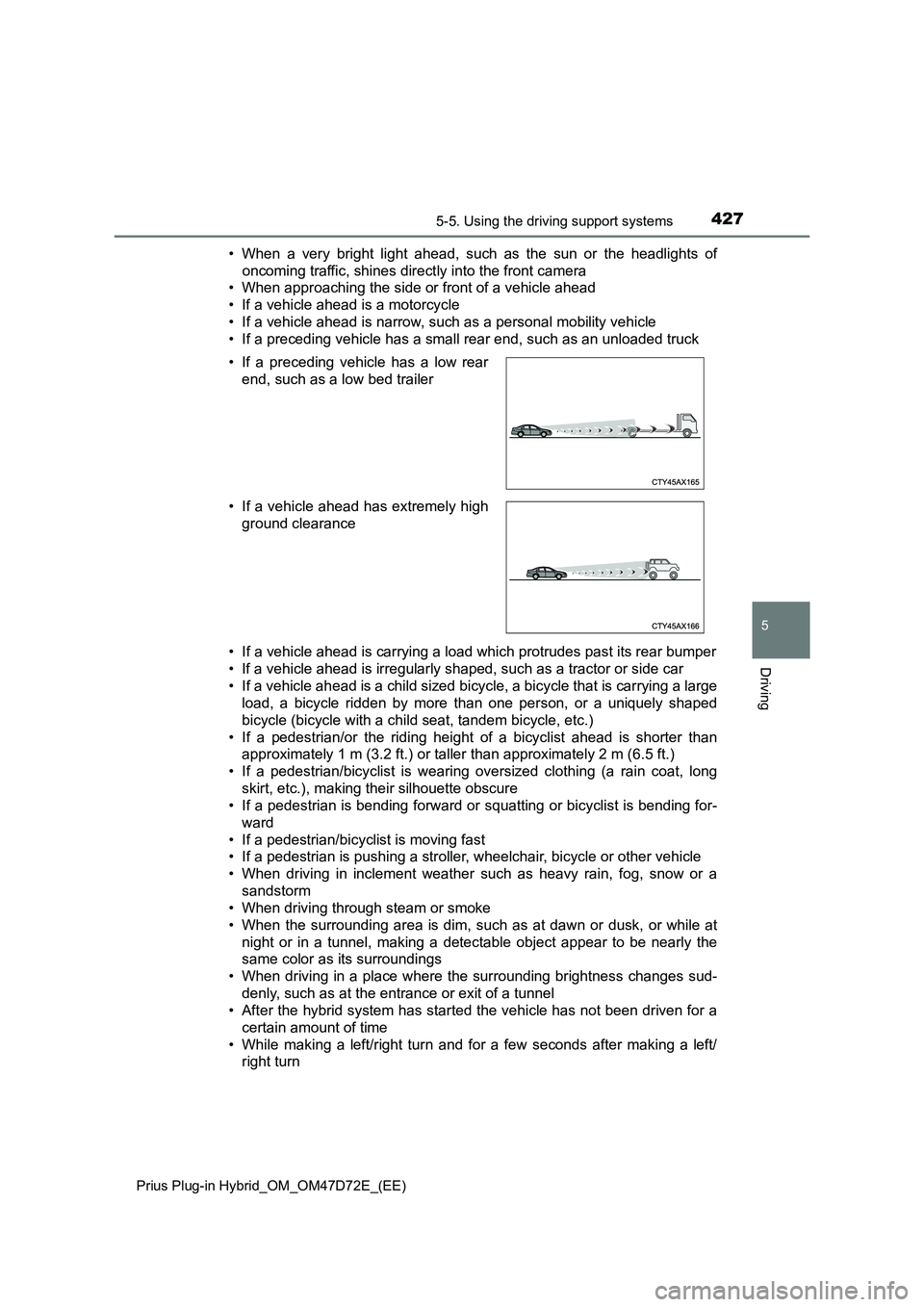
4275-5. Using the driving support systems
Prius Plug-in Hybrid_OM_OM47D72E_(EE)
5
Driving
• When a very bright light ahead, such as the sun or the headlights of
oncoming traffic, shines directly into the front camera
• When approaching the side or front of a vehicle ahead
• If a vehicle ahead is a motorcycle
• If a vehicle ahead is narrow, such as a personal mobility vehicle
• If a preceding vehicle has a small rear end, such as an unloaded truck
• If a vehicle ahead is carrying a load which protrudes past its rear bumper
• If a vehicle ahead is irregularly shaped, such as a tractor or side car
• If a vehicle ahead is a child sized bicycle, a bicycle that is carrying a large
load, a bicycle ridden by more than one person, or a uniquely shaped
bicycle (bicycle with a child seat, tandem bicycle, etc.)
• If a pedestrian/or the riding height of a bicyclist ahead is shorter than
approximately 1 m (3.2 ft.) or taller than approximately 2 m (6.5 ft.)
• If a pedestrian/bicyclist is wearing oversized clothing (a rain coat, long
skirt, etc.), making their silhouette obscure
• If a pedestrian is bending forward or squatting or bicyclist is bending for-
ward
• If a pedestrian/bicyclist is moving fast
• If a pedestrian is pushing a stroller, wheelchair, bicycle or other vehicle
• When driving in inclement weather such as heavy rain, fog, snow or a
sandstorm
• When driving through steam or smoke
• When the surrounding area is dim, such as at dawn or dusk, or while at
night or in a tunnel, making a detectable object appear to be nearly the
same color as its surroundings
• When driving in a place where the surrounding brightness changes sud-
denly, such as at the entrance or exit of a tunnel
• After the hybrid system has started the vehicle has not been driven for a
certain amount of time
• While making a left/right turn and for a few seconds after making a left/
right turn • If a preceding vehicle has a low rear
end, such as a low bed trailer
• If a vehicle ahead has extremely high
ground clearance